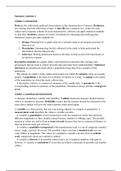Summary
Summary Statistics 1 Year 1.2 Psychology
- Course
- Institution
- Book
This is a summary for the course Statistics 1 of the first year of psychology. I studied with this summary and received an 8.4 for the exam. In the back of the summary, you will find a list where all the signs used in this course are explained (se, sigma, Q1, etc.). This summary is based on the boo...
[Show more]





